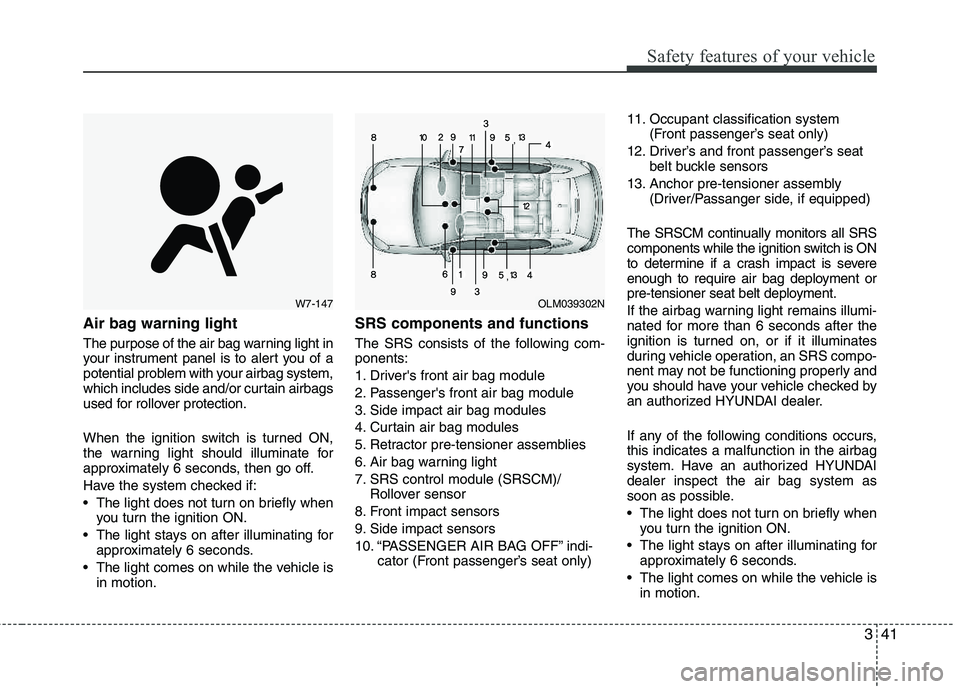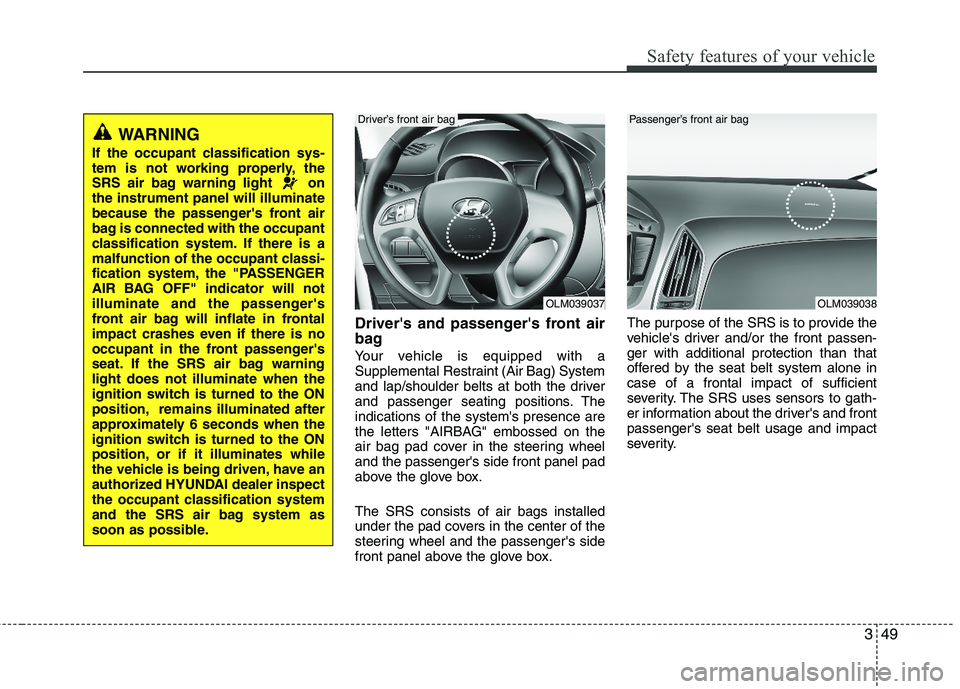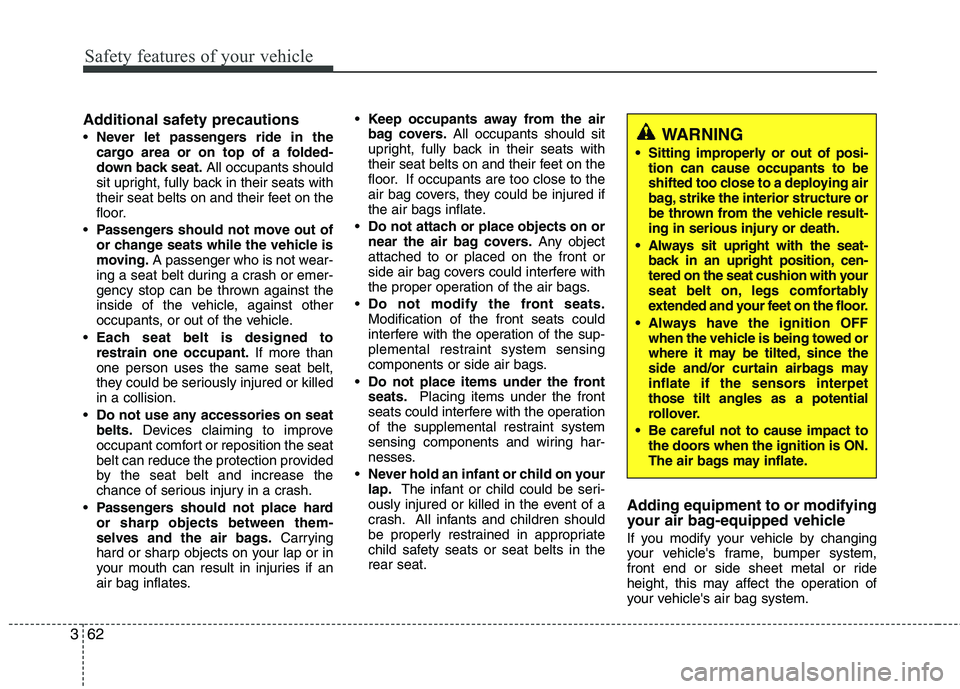2013 HYUNDAI TUCSON airbag off
[x] Cancel search: airbag offPage 58 of 397

341
Safety features of your vehicle
Air bag warning light
The purpose of the air bag warning light in
your instrument panel is to alert you of a
potential problem with your airbag system,
which includes side and/or curtain airbags
used for rollover protection.
When the ignition switch is turned ON,
the warning light should illuminate for
approximately 6 seconds, then go off.
Have the system checked if:
The light does not turn on briefly whenyou turn the ignition ON.
The light stays on after illuminating for approximately 6 seconds.
The light comes on while the vehicle is in motion.
SRS components and functions
The SRS consists of the following com- ponents:
1. Driver's front air bag module
2. Passenger's front air bag module
3. Side impact air bag modules
4. Curtain air bag modules
5. Retractor pre-tensioner assemblies
6. Air bag warning light
7. SRS control module (SRSCM)/
Rollover sensor
8. Front impact sensors
9. Side impact sensors
10. “PASSENGER AIR BAG OFF” indi- cator (Front passenger’s seat only) 11. Occupant classification system
(Front passenger’s seat only)
12. Driver’s and front passenger’s seat belt buckle sensors
13. Anchor pre-tensioner assembly (Driver/Passanger side, if equipped)
The SRSCM continually monitors all SRS
components while the ignition switch is ON
to determine if a crash impact is severe
enough to require air bag deployment or
pre-tensioner seat belt deployment.
If the airbag warning light remains illumi-
nated for more than 6 seconds after the
ignition is turned on, or if it illuminates
during vehicle operation, an SRS compo-
nent may not be functioning properly and
you should have your vehicle checked by
an authorized HYUNDAI dealer.
If any of the following conditions occurs, this indicates a malfunction in the airbag
system. Have an authorized HYUNDAI dealer inspect the air bag system as
soon as possible.
The light does not turn on briefly when you turn the ignition ON.
The light stays on after illuminating for approximately 6 seconds.
The light comes on while the vehicle is in motion.
OLM039302NW7-147
,,
Page 66 of 397

349
Safety features of your vehicle
Driver's and passenger's front air
bag
Your vehicle is equipped with a
Supplemental Restraint (Air Bag) System
and lap/shoulder belts at both the driver
and passenger seating positions. Theindications of the system's presence are
the letters "AIRBAG" embossed on the
air bag pad cover in the steering wheeland the passenger's side front panel pad
above the glove box. The SRS consists of air bags installed
under the pad covers in the center of the
steering wheel and the passenger's side
front panel above the glove box.The purpose of the SRS is to provide the
vehicle's driver and/or the front passen-ger with additional protection than that
offered by the seat belt system alone in case of a frontal impact of sufficient
severity. The SRS uses sensors to gath-
er information about the driver's and front passenger's seat belt usage and impact
severity.
OLM039037
WARNING
If the occupant classification sys-
tem is not working properly, the
SRS air bag warning light onthe instrument panel will illuminate
because the passenger's front air
bag is connected with the occupant
classification system. If there is a
malfunction of the occupant classi-
fication system, the "PASSENGER
AIR BAG OFF" indicator will not
illuminate and the passenger's
front air bag will inflate in frontal
impact crashes even if there is no
occupant in the front passenger's
seat. If the SRS air bag warning light does not illuminate when the
ignition switch is turned to the ON
position, remains illuminated after
approximately 6 seconds when the
ignition switch is turned to the ON
position, or if it illuminates while
the vehicle is being driven, have an
authorized HYUNDAI dealer inspect
the occupant classification system
and the SRS air bag system as
soon as possible.
OLM039038
Driver’s front air bag Passenger’s front air bag
Page 79 of 397

Safety features of your vehicle
62
3
Additional safety precautions
Never let passengers ride in the
cargo area or on top of a folded-
down back seat. All occupants should
sit upright, fully back in their seats with
their seat belts on and their feet on the
floor.
Passengers should not move out of
or change seats while the vehicle is
moving. A passenger who is not wear-
ing a seat belt during a crash or emer-
gency stop can be thrown against the
inside of the vehicle, against other
occupants, or out of the vehicle.
Each seat belt is designed torestrain one occupant. If more than
one person uses the same seat belt,
they could be seriously injured or killed in a collision.
Do not use any accessories on seat belts. Devices claiming to improve
occupant comfort or reposition the seat
belt can reduce the protection provided
by the seat belt and increase the
chance of serious injury in a crash.
Passengers should not place hardor sharp objects between them-
selves and the air bags. Carrying
hard or sharp objects on your lap or in
your mouth can result in injuries if an
air bag inflates.
Keep occupants away from the air
bag covers. All occupants should sit
upright, fully back in their seats with
their seat belts on and their feet on the
floor. If occupants are too close to the
air bag covers, they could be injured if
the air bags inflate.
Do not attach or place objects on or
near the air bag covers. Any object
attached to or placed on the front or
side air bag covers could interfere with
the proper operation of the air bags.
Do not modify the front seats.Modification of the front seats could
interfere with the operation of the sup-
plemental restraint system sensing
components or side air bags.
Do not place items under the front seats. Placing items under the front
seats could interfere with the operation
of the supplemental restraint system
sensing components and wiring har-
nesses.
Never hold an infant or child on yourlap. The infant or child could be seri-
ously injured or killed in the event of a
crash. All infants and children should
be properly restrained in appropriate
child safety seats or seat belts in therear seat.
Adding equipment to or modifying
your air bag-equipped vehicle
If you modify your vehicle by changing
your vehicle's frame, bumper system,
front end or side sheet metal or ride
height, this may affect the operation of
your vehicle's air bag system.
WARNING
Sitting improperly or out of posi- tion can cause occupants to be
shifted too close to a deploying air
bag, strike the interior structure or
be thrown from the vehicle result-
ing in serious injury or death.
Always sit upright with the seat- back in an upright position, cen-
tered on the seat cushion with your
seat belt on, legs comfortably
extended and your feet on the floor.
Always have the ignition OFF when the vehicle is being towed or
where it may be tilted, since the
side and/or curtain airbags may
inflate if the sensors interpetthose tilt angles as a potential
rollover.
Be careful not to cause impact to the doors when the ignition is ON.
The air bags may inflate.